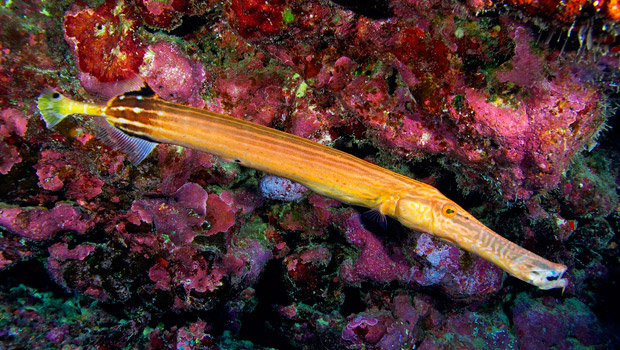Under the vast expanse of the ocean lies a world filled with unique and mesmerizing creatures. One such creature that captivates the imagination of divers and marine enthusiasts is the trumpet fish. With its elongated body and distinct features, the trumpet fish possesses various characteristics that make it a truly intriguing species. In this blog, we will dive into the ocean’s depths and uncover the trumpet fish’s fascinating characteristics.
1) Elongated Body: A Master of Camouflage
The trumpet fish boasts an elongated and slender body, resembling a musical instrument after which it is named. This body shape serves as a remarkable adaptation for blending into its surroundings. By mimicking the long, thin shapes of seaweed or coral, the trumpet fish can effectively camouflage itself and remain inconspicuous to potential predators and prey.
2) Vertical Orientation: Stealthy Hunter
One of the most distinctive features of the trumpet fish is its vertical orientation in the water. Unlike most fish that swim horizontally, the trumpet fish prefers to position itself vertically, with its head facing downward. This unique positioning allows it to blend in seamlessly with the vertical structures of the reef or other underwater habitats. By hovering motionlessly in this position, the trumpet fish becomes an adept ambush predator, patiently awaiting its prey.
3) Snout-like Mouth: Precision Predation
The trumpet fish possesses a highly specialized snout-like mouth, which sets it apart from other fish species. The mouth is long and tubular, resembling the shape of a trumpet, hence its name. This elongated mouth structure enables the trumpet fish to suction-feed on small fish and invertebrates with precision. It can extend its mouth rapidly to create a vacuum-like effect, sucking in unsuspecting prey within a fraction of a second.
4) Cryptic Coloration: Master of Disguise
The trumpet fish exhibits remarkable cryptic coloration to enhance its ability to blend in. Its body is adorned with intricate patterns and various colors, including shades of green, brown, yellow, and gray. This coloration allows the trumpet fish to mimic the surrounding environment, making it virtually invisible to potential predators and unsuspecting prey. Its ability to change color and patterns further aids in its camouflage, enabling it to adapt to different habitats and hide from danger.

5) Slow Swimming Speed: Patient Hunter
Despite its slender and streamlined body, the trumpet fish is not known for its speed. It moves through the water slowly and deliberately, conserving energy and maintaining a stealthy approach. This deliberate swimming style allows it to stalk prey and easily maneuver through intricate coral formations. By relying on its camouflage and patience, the trumpet fish can patiently wait for the perfect moment to strike.
6) Solitary Nature: Independent Wanderer
The trumpet fish is generally solitary, preferring to navigate the waters alone. It is often seen meandering through the reef or swimming among seagrass beds, exploring its surroundings leisurely. While it may occasionally form small groups or pairs, it typically leads a solitary existence. This independent nature allows the trumpet fish to adapt to its environment and explore various habitats with minimal social interactions.
The trumpet fish, with its elongated body, vertical orientation, specialized mouth, cryptic coloration, and patient hunting style, is a truly remarkable and enigmatic ocean creature. Its unique characteristics enable it to blend seamlessly with its surroundings, making it an exceptional predator and a master of disguise. As we continue to explore the wonders of the underwater world, the trumpet fish serves as a reminder of the diverse and awe-inspiring species that inhabit our oceans.
Don’t hesitate to share your thoughts with us in the comments below!

